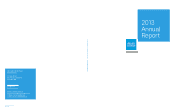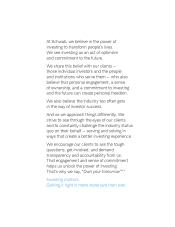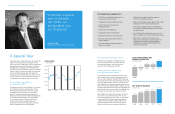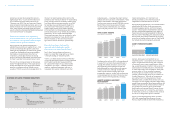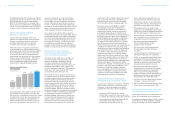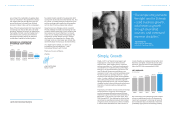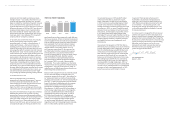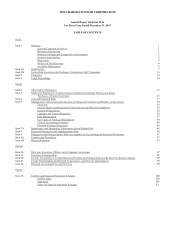Charles Schwab 2013 Annual Report Download - page 5
Download and view the complete annual report
Please find page 5 of the 2013 Charles Schwab annual report below. You can navigate through the pages in the report by either clicking on the pages listed below, or by using the keyword search tool below to find specific information within the annual report.
LETTER FROM THE CHIEF EXECUTIVE OFFICER 76 LETTER FROM THE CHIEF EXECUTIVE OFFICER
Fred Reichheld and Bain & Company, who together
pioneered the concept of promoter scoring, shows
that high Promoter Scores can be an effective
predictor of future growth for a company. And it
makes sense: If your clients feel so strongly about
the service you provide that they want to refer you
to others, your rm is likely to continue growing.
What are some of the things that
didn’t go so well in 2013?
Just as in the area of things that went well,
there are two categories here: those things that
didn’t go so well that we have no control over,
and those things that didn’t go so well that
we need to look in the mirror and address.
While the increase in long-term interest rates
in 2013 helped us, the Federal Reserve’s overall
policies governing interest rates were the dominant
environmental factor outside of our control that
hurt our nancial results. With the Fed Funds
target interest rate set at near zero, we continued
to waive money market fund fees — $674 million
in 2013. We did so to ensure that our clients
invested in Schwab managed money market
funds would not experience negative returns.
These waived fees come, dollar-for-dollar, off our
top-line revenue and, arguably, our bottom-line
pre-tax prots. And while the Fed started to loosen
up longer-term interest rates by moving toward a
reduction in its program of buying $85 billion of
xed income securities every month, those long-
term rates still remained at historical lows. As a
result, the spread that we could earn between
what we pay clients on their idle cash and what
we can invest it at was constrained. It did improve
but was still quite a bit less than what we expect
to earn in a more historically normal interest rate
environment. In fact, we believe the positive revenue
impact of a more normal interest rate environment
will be measured in billions of dollars per year.
Also outside of our control in 2013, despite the
outstanding year for the U.S. stock markets, was the
unexpectedly low level of our clients’ stock trading.
As a result, our trading revenue did not perform as
well as we had expected. Although we saw some
revenue growth in trading, our expectations were
for higher levels of trading based on historical
averages for years following a presidential election.
Frankly, our projections proved to be too optimistic.
Can you discuss some of the areas
that didn’t go as well in 2013 that were
not a result of the environment?
At Schwab, we put a high value on humility, and
we are much harder on ourselves than others
might be. We set high standards for serving
our clients, rewarding our stockholders with
consistent and strong nancial performance, and
meeting the expectations of our regulators with
our risk management capabilities. And sometimes
we fall short. Two areas where we didn’t meet
our standards in 2013 stand out to me.
First, we fell short of our goals for client access to
our systems last spring. We had instances where
our clients could not access our website or other
electronic systems due to malicious actions by
third parties. Although one could argue that this
issue has affected most major nancial institutions
in the United States and revolves around global
challenges that are beyond our control, we don’t
accept that answer. We have to do better, and we
will strive to be better. Every year we invest hundreds
of millions of dollars in maintaining and upgrading
our technology in an effort to ensure that it is
available whenever and however our clients want
to access Schwab. Subsequent to the downtime
issues we faced in early 2013, we have invested
millions more dollars in an effort to prevent the
same situation from recurring. Can I assure our
clients that it will never happen again? No, I cannot.
Can I assure them that all of us at Schwab, and
the technology rms we work with, are working
hard to avoid the situation happening again? Yes.
The second area I would highlight is related to
the challenges around the overall regulatory
environment. Schwab and our subsidiaries are
regulated by a number of governmental entities
including the Federal Reserve, the Ofce of the
Comptroller of the Currency, and the Securities and
Exchange Commission. Some of our subsidiaries
are also regulated by self-regulatory organizations
like the Financial Industry Regulatory Authority.
Our regulators have important jobs to do, and we
have deep respect for their professionalism and
efforts. We have a strong culture of compliance, and
compliance is inherent in most everything we do.
We spend tens of millions of dollars and thousands
upon thousands of hours of staff time every year
in an effort to comply with the myriad rules and
regulations applicable to our business. Despite
these efforts, we still incur regulatory nes. While
the amount of regulatory nes we incurred in 2013
was not material, and almost all of it was from a
recently acquired subsidiary, I am still disappointed
that we were subject to any nes at all. While I
know that it is unrealistic to ever expect this amount
to be zero, I will always be disappointed if it isn’t.
We take our compliance obligations seriously,
and as the regulatory environment continues to
increase in complexity, our people will continue
to strive to do great work on behalf of our clients
while meeting our regulatory responsibilities.
What stands out to you as particularly
innovative actions you undertook in 2013?
Last year was a huge year for innovation at Schwab.
But at Schwab, we strive to innovate not just for
the sake of it, but for the benet of our clients.
Advancements that come to mind from 2013 are:
»The launch of ETF OneSource™, offering
Schwab clients commission-free, online access
to 119 ETFs from Schwab and ve other providers;
»The introduction of the Schwab Accountability
Guarantee™, which offers a refund of
program fees paid by clients if, for any
reason, they are not happy with one of our
participating investment advisory services;
»Additions to our lineup of low-cost Schwab-
managed ETFs while our clients’ balances in
those ETFs nearly doubled to $16.9 billion;
»The growing reach of our brand through
expansion of our independent branch model,
ending the year with 24 independent branches
with strong momentum in leads and assets;
»The introduction of the Schwab Advisor Center®
app for Android™ devices to better serve our
independent investment advisor clients;
»The launch of the Schwab Retirement
Income Variable Annuity® to help
people at or near retirement;
»The introduction of the ThomasPartners®
dividend equity investment strategy to
our clients;
»Continued integration of optionsXpress into
Schwab and expansion of its capabilities;
»Growth of our groundbreaking Schwab Index
Advantage® 401(k) plan and preparation for
the launch of our full-service 401(k) program
that offers ETFs with real-time pricing and
investing, the rst major rm to do so;
»The introduction of Schwab OpenView
MarketSquare™, a review site that compiles
feedback and ratings from independent
RIAs on some of the leading technology
vendors and products in the industry, and our
online advisor directory to help individuals
nd an advisor who meets their needs;
»The launch of our new brand and advertising
campaign — Own your tomorrow™;
»Delivery of more than 100,000 nancial plans
for our clients, up 84 percent from 2012.
When you look to the future, what do you
see for Schwab and its stockholders?
I see a bright future for all our constituencies: our
clients, our stockholders, and our employees.
The multiyear strategy we began in 2009 to rebuild
investments in our client capabilities is paying
off. We are building trust with our clients and
MONEY MARKET FUND
FEE WAIVERS
(IN MILLIONS)
2009
$224
2013
$674
2012
$587
2010
$433
2011
$568

